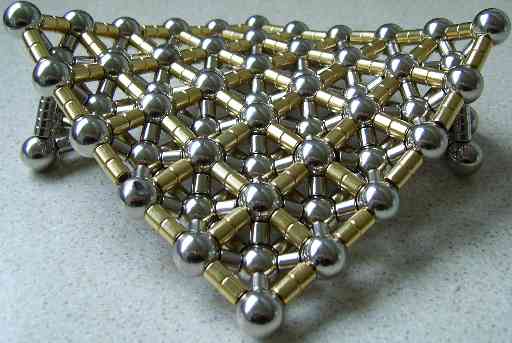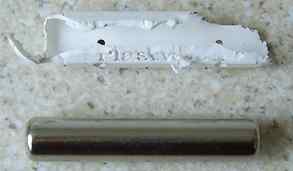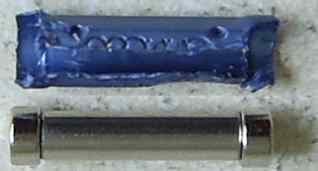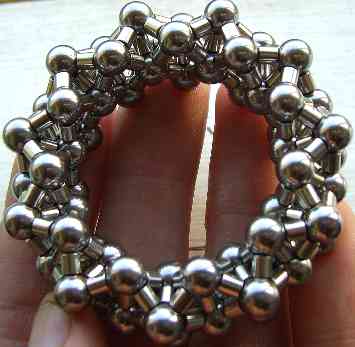
Magnetic models
Introduction
Combining ball bearing hubs with magnetic struts
makes constructing geometric models simple and easy.
Strong magnets have become inexpensive - and their use as
modelling materials has now become practical.
Galleries
To illustrate the potential of the medium, here are
a couple of galleries:

Neodymium magnet gallery

Plastic magnetic construction toy gallery
Strut length limitations
The plastic kits typically offer struts in a limited range
of lengths. While one manufacturer claims to offer seven
different lengths, to construct a reasonable range of
models, you would probably need to have struts of
configurable length.
The pure-neodymium route provides that capability without
much effort - since cylinder magents are available in
widths down to half a millimeter thick - allowing for
strut lengths to be varied with that sort of granularity
without much difficulty.
Magnet strength tests
The neodymium magnets were all N38 magnets
(a common-but-fairly-weak grade).
Stronger magnets help when building bigger models.
I did some strength testing of the various magnetic
modelling materials I had available:
|
Name
|
6mm
Rod |
6mm
Cyl |
Uni
Mag |
Geo
Mag |
Sup
Mag |
Mag
Stx |
Sup
Sml |
3mm
Rod |
Stx
Bls |
Mag
Max |
Wit
ka |
|
Strength
|

|

|

|

|

|

|

|

|

|

|

|
| Strength |
11 |
10 |
10 |
9 |
9 |
8 |
7 |
7 |
7 |
5 |
5 |
| Mass/l |
2.08 |
1.43 |
1.77 |
1.98 |
1.14 |
0.68 |
0.76 |
0.51 |
0.48 |
0.43 |
0.43 |
These tests all used 6mm ball bearings as the test weights.
Note that the strength scale is non-linear - the further
away each ball is, the greater increment in magenetic
strength it represents.
The mass/length figure doesn't make any attempt to factor in
the weight of the steel ball bearings. They make up a lot
of the weight in many kinds of model.
I dissected a couple of rods - to see how they were made:

Supermag
|

Geomag |
Geomag (and Unimag) use a 5mm diameter steel rod - to transmit magnetic
force between the poles of two 6mm diameter magents.
Supermag uses a single 5mm diameter solid magnet.
A few notes in summary:
The "raw" neodymium magnets are strongest. They also have
configurable lengths - and some have reasonable weight.
Of the commercial systems, Unimag was the strongest I tested.
Supermag scores highly in both strength and weight. It
comes in a range of lengths - and has a neat ability to fit
many rods around one ball.
Contention
Strong magnets can interfere with each other when placed in
close proximity to one another. Contention issues
do crop up with the neodymium models - but
essentially, it's usually no big deal.
Typically the magnets know which way around they are best
positioned, and they leap from your fingers onto to the
model while adopting that configuration. Sometimes they
leap to the wrong location - but they can be pulled off
again without too much bother.
Hollow cylinders
Most of the 6mm neodymium magnets have a 3mm hole bored into
them - which works well at keeping the magnet aligned with
the centre of the ball - and allows some parts of the magnet
to move slightly closer to the ball bearing.
Some magnetic strength is lost in the process of removing
the magnet's core - but the hollow tubular magnets seem
preferable to the solid cylindrical ones overall.
Scaling
To explore the possibilities offered by different size materials,
I purchased some 3mm tube magents and some 6mm ball bearings.

3mm neodymium magnet spaceframe
|

3mm neodymium magnet ring
|
Making the components larger or smaller seems unlikely to make
much difference to the range of models which could be
constructed.
Size does make quite a difference to construction cost,
though. Neodymium magnets are not yet so cheap that cost is
a negligible factor.
Unfortunately, there are some disadvantages to using smaller magnets:
- They are more difficult to manipulate with your fingers;
- Hollow cylindrical versions are not easily available much below 6mm;
- The thinnest magnet is still 0.5mm thick - so there are more length-quantization issues;
Generally, the 6mm magnets used in most kits seems like a
reasonable size to me.
The modeling stratgey would benefit somewhat from the use of
hollow ball bearings.
However, unfortunately, hollow and light ball bearings do
not yet seem to be widely available.
Spheres

Neodymium magnetic spheres
Modelling with magnetic spheres is also possible.
See the neodymium magnetic sphere
page for more details.
Hazzards
There are various dangers associated with neodymium magnets.
The small ones seem pretty safe to me. I smashed a few thin
ones while making these models, but none of them sent shards
of neodymium into sensitive parts of my body.
Some people have sensitivities to nickel. I don't seem to
be one of them, and am not too concerned about absorbing
heavy metals through my fingers from these components.
Magnetic modelling can be fun - and doing too much of it
might waste your time and or give you RSI. Nontheless,
I rate magnetic modelling as a fairly low addiction risk
activity - and a moderate-to-low RSI risk hazzard.
If you have small kids, you might want to think twice
about leaving these components lying around.
There are a number of other potential hazzards with
magnets - read the warnings and take appropriate care.
Links
Neodymium modelling
Geomag
Magnetic sculpture
WonderMagnet
Amazing Magnets' Superball Kit - reviewed
Amazing Magnets
Magnet suppliers
Eclipse magnetics
Magnet UK
supermagnete.de
Neodymium magnets on eBay (UK)
Unimag (supplier)
Bulk magnet suppliers
Dadao group - from China
Magnets-China - from China
Plastic magnetic kits
Magz - makers of the "Skrooz" variable-length strut system
Supermag
Geomag
Magnetix
ToyMagnets
RogersConnection
Some interesting models
Models pages
Supermag models
Roger's Connection
Non-magnetic construction kits
Astro Logix
TekKit
Zome
GeoShapes
Polymorf
PolyDron
JovoToys
Geometric Models - links
Geometry junkyard - toy links
Tim Tyler |
Contact |
http://hexdome.com/
|